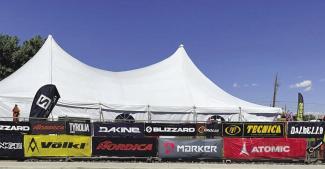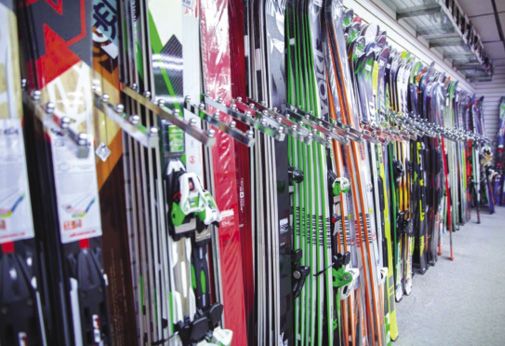Commentary: The Reckoning to Come

Online sales have soured relations between big ski brands and their dealers, but the pendulum will swing back.
The sands beneath the ski trade’s foundations have shifted to the point that the supplier community is engaged in direct competition with its local dealers. Changes in brand ownership have resulted in the behind-the-scenes dismantling of entire management teams, not because they were unsuccessful, but because they were quite the opposite, and therefore cost too much to retain.
I’m compelled to highlight the rot below the ski trade’s sunny surface because many skiers harbor deep brand loyalties that are no longer merited. In my lifetime, perhaps no brand has spoken more directly to, and connected more deeply with, the North American skiing public than K2. Fans of the brand should know that the people who built and maintained the brand are long gone. The husk of a brand the robber barons have left in their wake seems determined to alienate a once fiercely loyal dealer base.

It all began several ownerships ago, when K2 was part of a bundle of ski properties assembled by Jarden, a diverse consumer products conglomerate that was sold to Newell Brands for $16 billion in 2016. At the time, the incoming CEO assured doubtful investors that if the handful of ski brands Newell had acquired didn’t find a buyer, he would simply liquidate them rather than see them dilute the bottom line.
This declaration makes it clear that the entire ski trade has never been more than a rounding error for Wall Street.
K2’s current owner, Kohlberg and Company, has been trying to offload its entire ski-related portfolio (K2, Völkl, Line, Dalbello, Marker and BCA), bundling them all into a renamed entity, Elevate Outdoor Collective. A deal for Elevate Outdoor Collective was almost consummated about three years ago, but when it came unglued, K2’s overseers stripped it down to essentials, shedding any expense that diminished gross margin. The brand dropped out of trade shows and amped up direct-to-consumer sales with a carpet-bombing Internet campaign, thus reminding ski retailers several times a week that they would be fools to compete with direct-from-the-factory sales.
It’s unclear whether online sales will compensate for lost sales in shops. Meanwhile, Elevate Outdoor Collective centralized a lot of corporate functions so that brands would no longer have (for instance) their own accounting departments. Völkl saw its offices shuttered and its entire management team, inarguably one of the best in the U.S., prodded off the retirement plank or dismissed outright after a five-minute exit interview. Völkl is currently in the care of Tracy Gibbons, a well-respected ski industry veteran who formerly served at the helm of Sturtevant’s in Seattle and most recently managed the hardgoods category at Christy Sports.
Fortunately, Völkl kept its product-engineering staff. But since they’re dependent on the parent company for mission-critical functions, the Elevate Outdoor Collective brands are no longer capable of independent operation, so they can’t be sold individually. It’s the whole package or nothing.
If K2’s only offense was selling against its own dealers, it would simply be engaging in what has become accepted practice. Almost all the major brands now sell direct to consumer, in competition with their dealers. But K2 went further, creating a special ski line that it sold only online and at unrealistic, elevated pricing. This silly adventure into a price range K2 will never inhabit showed how willing the company was to compete directly with the very dealers that built the brand.
One K2 dealer, Dallas Goldsmith of Goldsmith’s Sports in Big Bear Lake, California, sums up his position: “What’s sad to me is that in the corporate world we live in, we are continuing to make it more difficult for the true mom and pop shops to survive. I love the K2 brand, always have, but they’ve certainly changed my perspective with their move out of the winter sports retailer family and their direct-to-consumer approach. But like I always do, I will look at this as a challenge from K2 rather than a slap in the face, which is what it really is.”
Like Goldsmith, most dealers take the slap and turn the other cheek.
The fact is, the retail community prizes its brand partnerships. No one wants to sever relations with an important brand that the shop has promoted for years. Retailers spend a lot of their own time and money building the brands they represent; it’s a big investment to walk away from. Perhaps most importantly, ours is a person-to-person business; shops form relationships with the reps who cater to them. There are people involved in this equation.
At the end of the day, the shop is going to prefer to keep the door open, so savvy specialists will stock what they feel they must to maintain a relationship. Even K2 will surely rise again, buoyed by its strong brand image with consumers and long-standing retailer relationships.
Even if every skier in the world bought his or her skis online, skiers still need someplace to go for expert boot-fitting and binding service, without which it doesn’t much matter what ski you wind up with. Brands need specialty retailers to provide essential services not shippable by UPS, and the shops need strong, engaged brands that deliver on skier expectations for performance. If we are at a nadir of supplier-retailer relations, it should also mean that better days are just one sales cycle away. 
Regular contributor Jackson Hogen has held marketing positions at Salomon and Head, ran the ski-testing program for Snow Country and operates Realskiers.com.